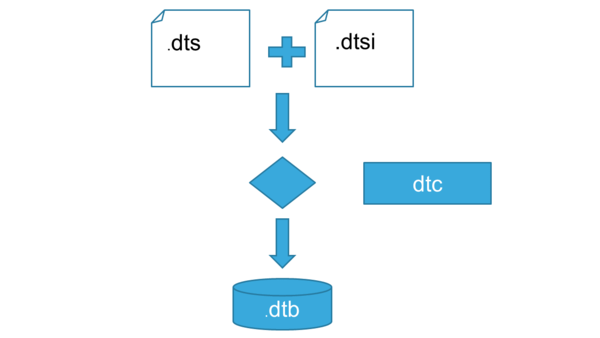1. Purpose[edit source]
The objective of this chapter is to give general information about the device tree.
An extract of the device tree specification[1] explains it as follows:
"A device tree is a tree data structure with nodes that describe the devices in a system. Each node has property/value pairs that describe the characteristics of the device being represented. Each node has exactly one parent except for the root node, which has no parent. ... Rather than hard coding every detail of a device into an operating system, many aspect of the hardware can be described in a data structure that is passed to the operating system at boot time."
In other words, a device tree describes the hardware that can not be located by probing. For more information, please refer to the device tree specification[1]
1.1. Source files[edit source]
- .dts: The device tree source (DTS). This format is a textual representation of a device tree in a form that can be processed by DTC (Device Tree Compiler) into a binary device tree in the form expected by software components: Linux® Kernel, U-Boot and TF-A.
- .dtsi: Source files that can be included from a DTS file.
1.2. Bindings[edit source]
The device tree data structures and properties are named bindings. Those bindings are described in:
- The Device tree specification[1] for generic bindings.
- The software component documentations:
- Linux® Kernel: Linux kernel device tree bindings
- U-Boot: U-Boot device tree bindings
- TF-A: TF-A device tree bindings
1.3. Build[edit source]
- A tool named DTC (Device Tree Compiler) allows compiling the DTS sources into a binary.
- input file: the .dts file described in section above.
- output file: the .dtb file described in section above.
- More information are available in DTC manual[2].
- DTC source code is located here[3]. DTC tool is also available directly in particular software components: Linux Kernel, U-Boot, TF-A .... For those components, the device tree building is directly integrated in the component build process.
1.4. Tools[edit source]
The device tree compiler offers also some tools:
- fdtdump: Print a readable version of a flattened device tree file (dtb)
- fdtget: Read properties from a device tree
- fdtput: Write properties to a device tree
- ...
There are several ways to get those tools:
- In the device tree compiler project source code[3]
- Directly in software components: Kernel, u-boot, tf-a ...
- Available in Debian package[4]
2. STM32[edit source]
For STM32MP1, the device tree is used by three software components: Linux® kernel, U-Boot and TF-A.
The device tree is part of the OpenSTLinux distribution. It can also be generated by STM32CubeMX tool.
To have more information about the device tree usage on STM32MP1 (how the device tree source files are split, how to find the device tree source files per software components, how is STM32CubeMX generating the device tree ...) see STM32MP15 device tree page.
3. How to go further[edit source]
- Device Tree for Dummies[5] - Free Electrons
- Device Tree Reference[6] - eLinux.org
- Device Tree usage[7] - eLinux.org
4. References[edit source]
- ↑ Jump up to: 1.0 1.1 1.2 https://github.com/devicetree-org/devicetree-specification/releases/tag/v0.2(latest) ,Device tree specification
- ↑ https://git.kernel.org/pub/scm/utils/dtc/dtc.git/tree/Documentation/manual.txt(master) ,DTC manual
- ↑ Jump up to: 3.0 3.1 https://git.kernel.org/pub/scm/utils/dtc/dtc.git(master) ,DTC source code
- ↑ https://packages.debian.org/search?keywords=device-tree-compiler(master) ,DTC debian package
- ↑ Device Tree for Dummies, Free Electrons
- ↑ Device Tree Reference, eLinux.org
- ↑ Device Tree Usage, eLinux.org
